Recently, a GT reader commented favorably on our ongoing ammunition testing. He liked the testing and found it informative. He wondered if we would be willing to conduct an extensive test of 9mm Luger ammunition.
The suggested test would involve subcompact, compact, and service-length-barrel handguns. This could mean barrel lengths of about 3.5 to 4.9 inches. The editor suggested we add a carbine-length 9mm as well because the 9mm is popular in both handguns and carbines.
But choosing the right handgun load is important. As an example, a load that expands readily in the shortest-barrel 9mm might expand too quickly for optimum performance at higher velocity from a service-grade handgun.
By the same token, a load that expands well from the 4.9-inch barrel might not expand at all or poorly from a short-barrel handgun. The problem is magnified when a 9mm carbine is part of the firearms battery.
So we set out on an extensive test. We fired more than 2,000 cartridges over a period of 14 months. Our goal was to find an all-round load that performed well in all the platforms but that didn’t beat up the shooter or the guns.
9MM Luger Load Performance Data
Notes: Average Velocity and standard deviation readings were obtained by firing four five-shot strings over a Competition Electronics Pro Chrono. Ambient temperature: 86 degrees. Elevation: 815 feet above sea level. The accuracy figures are the average of two five-shot groups. For accuracy, we fired the test gun from a benchrest at a 15-yard target. To calculate IPSC power factor, multiply bullet weight in grains by the velocity in fps, then divide by 1000. The retained-weight column shows the recovered bullet weight as a percentage of the actual bullet weight.| Cartridge | Firearms | Average Velocity (fps) | Standard Deviation (fps) | Muzzle Energy (ft.-lbs.) | IPSC Power Factor | Average Accuracy (in.) | Expanded Width (in.) | Retained Weight (gr.) | Retained Weight % | Penetration In Water (in.) | Gun Tests Grade |
|---|---|---|---|---|---|---|---|---|---|---|---|
| 115-grain Fiocchi XTP | Glock 43X | 1130 | 9 | 326 | 130 | 1.3 | 0.52 | 115 | 100 | 16 | A |
| Glock 45 | 1166 | 12 | 347 | 134 | 1.3 | 0.52 | 115 | 100 | 16 | A | |
| Glock 17 | 1174 | 10 | 352 | 136 | 1.3 | 0.53 | 115 | 100 | 16 | A | |
| KelTec Sub-2000 | 1240 | 11 | 393 | 143 | 0.75 | 0.55 | 115 | 100 | 18 | A | |
| 124-grain Fiocch XTP | Glock 43X | 1115 | 14 | 342 | 138 | 2 | 0.5 | 124 | 100 | 17 | A |
| Glock 45 | 1119 | 7 | 345 | 139 | 2.1 | 0.5 | 124 | 100 | 18 | A | |
| Glock 17 | 1140 | 16 | 358 | 141 | 1.5 | 0.52 | 124 | 100 | 18 | A | |
| KelTec Sub-2000 | 1190 | 14 | 390 | 148 | 1.1 | 0.54 | 122 | 99 | 20 | A | |
| 124-grain Hornady American Gunner +P | Glock 43X | 1214 | 14 | 406 | 150 | 3 | 0.54 | 122 | 99 | 20 | A |
| Glock 45 | 1222 | 12 | 411 | 151 | 2.3 | 0.54 | 124 | 100 | 20 | A | |
| Glock 17 | 1246 | 12 | 427 | 154 | 2.5 | 0.55 | 123 | 99.5 | 22 | A | |
| KelTec Sub-2000 | 1301 | 19 | 466 | 161 | 1.8 | 0.62 | 122 | 99 | 24 | A | |
| 124-grain Speer Gold Dot +P | Glock 43X | 1198 | 16 | 395 | 148 | 4 | 0.64 | 124 | 100 | 17 | A |
| Glock 45 | 1222 | 22 | 411 | 151 | 2.5 | 0.64 | 124 | 100 | 18 | A | |
| Glock 17 | 1258 | 12 | 436 | 156 | 2 | 0.69 | 124 | 100 | 18 | A | |
| KelTec Sub-2000 | 1305 | 24 | 469 | 162 | 1.2 | 0.75 | 124 | 100 | 20 | A | |
| 124-grain Remington Golden Saber | Glock 43X | 1090 | 21 | 327 | 135 | 4.2 | 0.58 | 124 | 100 | 18 | A |
| Glock45 | 1111 | 17 | 340 | 138 | 2 | 0.58 | 124 | 100 | 18 | A | |
| Glock 17 | 1130 | 13 | 351 | 140 | 2.5 | 0.59 | 124 | 100 | 18 | A | |
| KelTec Sub-2000 | 1180 | 30 | 383 | 146 | 1.7 | 0.78 | 120 | 95 | 18 | A | |
| 124-grain Hornady FlexLock +P | Glock 43X | 1129 | 10 | 351 | 140 | 2.9 | 0.54 | 124 | 100 | 19 | A |
| Glock 45 | 1150 | 12 | 364 | 143 | 2.4 | 0.55 | 124 | 100 | 18 | A | |
| Glock 17 | 1163 | 11 | 372 | 144 | 1.7 | 0.56 | 124 | 100 | 18 | A | |
| KelTec Sub-2000 | 1201 | 19 | 397 | 149 | 1.2 | 0.58 | 124 | 100 | 20 | A | |
| 147-grain SIG Sauer V-Crown | Glock 43X | 940 | 13 | 288 | 138 | 4 | 0.59 | 147 | 100 | 14 | A |
| Glock 45 | 954 | 14 | 297 | 140 | 3 | 0.6 | 147 | 100 | 14 | A | |
| Glock 17 | 969 | 17 | 306 | 142 | 2.9 | 0.61 | 147 | 100 | 15 | A | |
| KelTec Sub-2000 | 1090 | 24 | 388 | 160 | 0.9 | 0.69 | 147 | 100 | 17 | A | |
| 147-grain Speer Gold Dot | Glock 43X | 911 | 18 | 271 | 134 | 4.2 | 0.55 | 147 | 100 | 15 | A |
| Glock 45 | 955 | 33 | 298 | 140 | 3 | 0.58 | 147 | 100 | 15 | A | |
| Glock 17 | 951 | 16 | 295 | 139 | 2 | 0.58 | 147 | 100 | 15 | A | |
| KelTec Sub-2000 | 1080 | 22 | 381 | 159 | 1 | 0.62 | 147 | 100 | 16 | A | |
| 147-grain Browning X Bullet | Glock 43X | 913 | 10 | 272 | 134 | 3.8 | 0.46 | 147 | 100 | 18 | B |
| Glock 45 | 918 | 11 | 275 | 135 | 2.5 | 0.47 | 147 | 100 | 18 | B | |
| Glock 17 | 941 | 14 | 289 | 138 | 2.8 | 0.44 | 147 | 100 | 18 | B | |
| KelTec Sub-2000 | 1060 | 11 | 367 | 156 | 1.8 | 0.45 | 147 | 100 | 20 | B |
The 9mm is everyman’s caliber these days, and it isn’t unusual for shooters to carry different-size 9mm handguns, depending on the weather. The same shooter may keep a 9mm carbine for home defense. We think it is better for the multi-gun 9mm shooter to have one or two loads on hand for optimal performance in different firearms and situations.
We do want to note that the primary advantage of the 9mm carbine will be in accuracy and shot placement. The 9mm doesn’t gain as much velocity from a 16-inch carbine as some might think. As a comparison, the 357 Magnum often gains several hundred feet per second in a carbine. In 9mm, a difference of 100 fps is considered a big plus. It was interesting that the heavy 147-grain loads gained the most in the carbine, up to 169 fps with the Speer Gold Dot bullet.
In the test, we used three handguns, a Glock 43X with 3.39-inch barrel, the Glock 45 with a 4.02-inch barrel, and the Glock 17 with 4.49-inch barrel. The carbine was a KelTec Sub 2000 with a 16-inch barrel.
We fired into water jugs to test expansion and penetration. While only one load was a truly poor performer, some were better than others. In the end, the middle of the road in weight and velocity isn’t a bad place to be. Here are the round-by-round summaries.
Fiocchi 115-Grain XTP
The Fiocchi load is more affordable in 50-round boxes, and those are what you should seek. Velocity ran 1130 to 1240 fps, picking up quite a bit in the carbine. Expansion was very consistent at 0.52 to 0.55 inch. Penetration in water was 16 to 18 inches. We liked this load based on expansion, penetration, and low recoil.
GUN TESTS GRADE: A-
Fiocchi 124-Grain XTP
The 124-grain Fiocchi load demonstrated more penetration, 17 to 20 inches, than the 115-grain load. Expansion was slightly less at 0.50 to 0.54 inch, but very consistent. It isn’t as fast as some other loads, but we like the balance of expansion and penetration, and it doesn’t introduce heavy recoil into even lightweight handguns. In the carbine, it hits like a +P from a pistol, but with light recoil and modest pressure.
GUN TESTS GRADE: A
Hornady 124-Grain +P
We wanted to test +P loads as well as standard loads and we are glad we did. Expansion and penetration in the pistols was just a bit over the standard-velocity Fiocchi load. Velocity in the pistols began at 1214 fps. In the carbine, velocity jumped to a solid 1301 fps. Penetration ran from 20 to 24 inches and expansion 0.55 to 0.62 inch. This is a load that maximizes the carbine length barrel and offers two feet of penetration. Yet, it is controllable. You have to decide if you wish to run +P loads in your handguns.
GUN TESTS GRADE: A-
Speer Gold Dot 124-Grain +P
The Speer Gold Dot +P offers similar performance to the American Gunner +P with velocity of 1198 to 1305 fps, slightly slower in the handgun compared to the Hornady +P and slightly faster in the carbine. This bullet showed the greatest increase in expansion when fired in a carbine, from 0.64 in the pistol to a startling 0.75 from the carbine. Penetration is 17 to 20 inches. We feel that it would make an excellent home-defense load in both short arms and long arms.
GUN TESTS GRADE: A-
Remington 124-Grain Golden Saber
The Remington Golden Saber +P offered a clean powder burn and reliable feeding. Velocity ran from 1090 to 1180 fps. Penetration was very consistent at 18 inches, with little to no deviation between the different firearms. Expansion ranged from 0.58 to 0.78 inch, with the higher number the result of a consistent outcropping of the Golden Saber jacket. The Golden Saber offers reasonable performance from the handgun and very good performance from the carbine at standard pressure.
GUN TESTS GRADE: A-
Hornady 124-Grain FlexLock +P
This is among the most consistent loads we have tested. The standard deviation, which is the difference in velocity between shots, was as low as 10 fps. Penetration was also consistent at 18 to 24 inches. Expanded bullets were between 0.54 to 0.58 inch. Velocity ranged from 1129 to 1201 fps.
GUN TESTS GRADE: A-
SIG Elite 147-Grain V-Crown
The 147-grain V-Crown exhibited velocity of 940 to 1090 fps, the fastest overall of the heavyweight bullets. You have to look hard at the performance. Some purchase a 147-grain loading for increased penetration. In the handguns, average penetration was 14 inches. In the carbine, 17 inches, with expansion picking up from 0.59 to 0.64 inch. So the load did not blow up at higher velocity. This looks good for home defense in both handguns and carbines.
GUN TESTS GRADE: A-
Speer Gold Dot 147-Grain
The Speer Gold Dot features a bonded bullet that is manufactured literally by punching a hole in the original jacketed core. The Gold Dot has been in use a considerable time, and in previous tests, it has given good results in most scenarios. The Gold Dot is at its best at higher velocity, but it expanded even at the lowest velocity in the Glock 43 9mm. Penetration remained remarkably consistent at 15 to 16 inches, despite a difference in muzzle velocity from 911 to 1080 fps. Expansion was 0.55 to 0.62 inch. There was more disruption of the water jugs at higher velocity. If you like the 147-grain weight and deep penetration, this is a viable loading. Performance is little affected by velocity. We prefer the performance of other loads in the shorter-barrel handguns.
GUN TESTS GRADE: A-
Browning 147-Grain X Bullet Hollow Point
This round’s expansion was poor, running from 0.46 to 0.50 inch. One bullet failed to expand at all. There were so many other choices, we’d pass on this one.
GUN TESTS GRADE: B
Our Team Said
During the testing, we took notes and compared expanded bullets and worked to eliminate some choices. To our surprise, we found the sweet spot of performance and shootability in the middle.
- The Browning 147-grain X bullet and the Fiocchi 115-grain JHP were first to go — the Fiocchi 115 simply because we liked the Fiocchi 124-grain load better.
- If you prefer a 147-grain load, the Speer Gold Dot and the SIG Sauer V-Crown are viable choices.
- All handguns are not as suitable for +P loads as the Glocks. The three 124-grain +P loads included the Hornady American Gunner and Hornady FlexLock as well as the Speer Gold Dot. Total expansion favors the American Gunner, just slightly, over the FlexLock. The Gold Dot 124-grain +P exhibits the best expansion in the carbine. If you feel like you and your firearm are up to +P use, take your pick of the 124-grain choices from the table above.
- Overall, we preferred the 124-grain loads for multi-gun use. The Fiocchi 124-grain XTP and the Remington 124-grain Golden Saber, operating at standard pressure, would be acceptable loads for pistol and carbine use. While there are individual reasons for choosing a load over the other, we feel that the performance of the standard-pressure 124-grain loads is ideal for long-term use, so we’d start here by looking at function in our guns.
Written and photographed by Gun Tests Staff, using evaluations from Gun Tests team testers.




























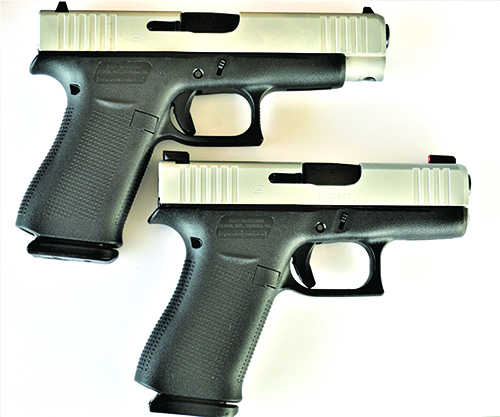
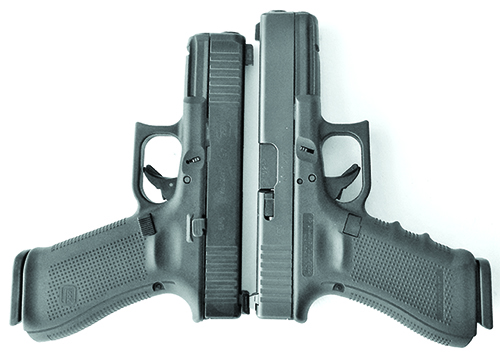
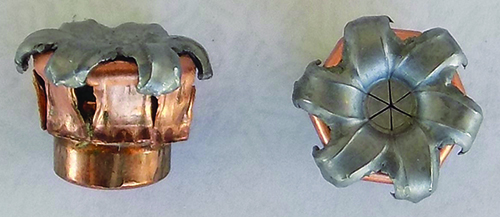

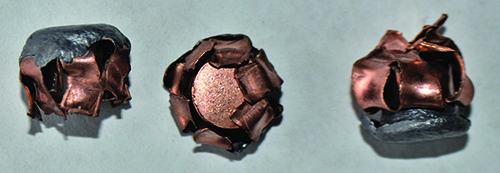


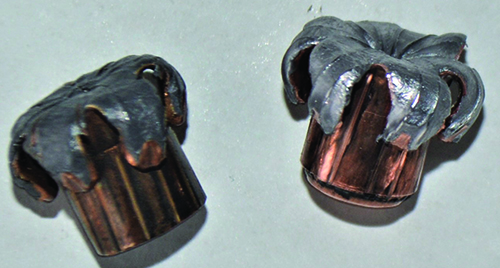


If as you correctly pointed out bullet expansion is directly related to the speed, and speed is directly related to barrel length, than why is the listing by gun make and model and not barrel length. (Where is the 3.12″ barrels like the SIG P938/P365.) This would be critical knowledge for the shorter barrel users? Do we assume the Glock 43 (3.39), is close enough to 3.12 that expansion / performance would be the same?
I find the addition of the carbine to be less then useful and a curiosity at best as they are not usually a carry gun and would probably use ball ammo in a home defense role.
I think Gun Tests readers are sophisticated enough to know the barrel length of their handguns.
Otherwise it is nice article but not complete both in selection of barrel lengths and modern defense ammo selected.
Your comparison of the 9mm vs. the .357 in a 4” barrel compared to a 16” helped me better understanding of the effects of unburned powder.
According to your statistics, the 9mm makes the most efficient use of powder in a short barrel as opposed to a 357.
Thank you for your easy to understand explanation.
Great study Todd. I always thought the 9mm had more velocity out of 16″ vs 4″ barrel. As the previous post said the 9mm does make most efficient use of powder. In the early 90’s I chronographed 2 different loads in a Glock 24L, a Glock 22, Glock 23, and my edc Glock 27. I was shocked at how little difference in the 40 cal between the Glock 24L vs the shorty Glock 27. The 45acp is a popular choice but only in the 4 1/4″ barrels and up. If you want a 45acp in a 3″ barrel you need to go to the 9mm or .40. By the way the .40 isn’t dead yet, I enjoy your magazine and was one of the first subscribers a long time ago. Keep up the good work.
I have tested pistols versus Carbine and seen that you dont have nearly as much drop. at say 200 feet. 4 in versus 9 inch barrel. based on my test I assume it was velocity effects but your saying no. Now Im confused. I will be redoing my testing soon. and adding a 16″ to the mix. not keltec. Ruger carbine.